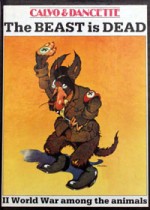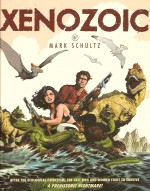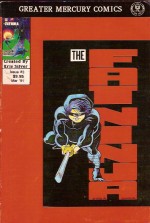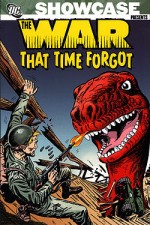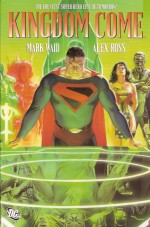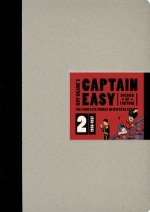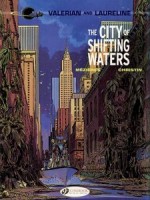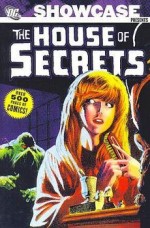
By various (DC Comics)
ISBN: 978-1-84856-054-3
American comicbooks started slowly until the creation of superheroes unleashed a torrent of creative imitation and invented a new genre. Implacably vested in the Second World War, the Overman swept all before him (and very occasional her or it) until the troops came home and the more traditional genres resurfaced and eventually supplanted the Fights ‘n’ Tights crowd.
Although new kids kept up the buying, much of the previous generation also retained their four-colour habit but increasingly sought older themes in the reading matter. The war years altered the psychological landscape of the world and as a more world-weary, cynical young public came to see that all the fighting and dying hadn’t really changed anything, their chosen forms of entertainment (film and prose as well as comics) reflected this. As well as Western, War and Crime comics, celebrity tie-ins, madcap escapist comedy and anthropomorphic funny animal features were immediately resurgent, but gradually another of the cyclical revivals of spiritualism and public fascination with the arcane led to a wave of increasingly impressive, evocative and shocking horror comics.
There had been grisly, gory and supernatural stars before, including a pantheon of ghosts, monsters and wizards draped in mystery-man garb and trappings (the Spectre, Mr. Justice, Sgt. Spook, Frankenstein, The Heap, Sargon the Sorcerer, Zatara, Zambini the Miracle Man, Kardak the Mystic, Dr. Fate and dozens of others), but these had been victims of circumstance: the Unknown as a power source for super-heroics. Now the focus shifted to ordinary mortals thrown into a world beyond their ken with the intention of unsettling, not vicariously empowering the reader.
Almost every publisher jumped on the increasingly popular bandwagon, with B & I (which became the magical one-man-band Richard E. Hughes’ American Comics Group) launching the first regularly published horror comic in the Autumn of 1948, although Adventures Into the Unknown was technically pipped by Avon who had released an impressive single issue entitled Eerie in January 1947 before launching a regular series in 1951, by which time Classics Illustrated had already long milked the literary end of the medium with adaptations of the Headless Horseman, Dr. Jekyll and Mr. Hyde (both 1943), The Hunchback of Notre Dame (1944) and Frankenstein (1945) among others.
If we’re keeping score this was also the period in which Joe Simon and Jack Kirby identified another “mature market†gap and invented the Romance comic (Young Romance #1, September 1947) but they too saw the sales potential for spooky material, resulting in the seminal Black Magic (launched in 1950) and boldly obscure psychological drama anthology Strange World of Your Dreams (1952).
The company that would become DC Comics bowed to the inevitable and launched a comparatively straight-laced anthology that nevertheless became one of their longest-running and most influential titles with the December 1951/January 1952 launch of The House of Mystery.
When the hysterical censorship scandal which led to witch-hunting hearings (feel free to type Senate Subcommittee on Juvenile Delinquency, April- June 1954 into your search engine at any time… You can do that because it’s apparently a free country now) was curtailed by the industry adopting a castrating straitjacket of self regulatory rules. Horror titles produced under the aegis of the Comics Code Authority were sanitised and anodyne affairs in terms of Shock and Gore but the appetite for suspense was still high and in 1956 National introduced the sister title House of Secrets which debuted with a November-December cover-date.
Stories were dialled back into marvellously illustrated, rationalistic, fantasy-adventure vehicles which dominated the market until the 1960s when super-heroes (which had started to creep back after Julius Schwartz began the Silver Age of comics by reintroducing the Flash in Showcase #4, 1956) finally overtook them. Green Lantern, Hawkman, the Atom and a slew of other costumed cavorters generated a gaudy global bubble of masked mavens which even forced the dedicated anthology suspense titles to transform into super-character split-books with Martian Manhunter and Dial H for Hero in House of Mystery and Mark Merlin -later Prince Ra-Man – sharing space with Eclipso (see Showcase Presents Eclipso) in House of Secrets.
When the caped crusader craziness peaked and popped, Secrets was one of the first casualties and the title folded with #80, the September-October 1966 issue.
However nothing combats censorship better than falling profits and at the end of the 1960s the Silver Age superhero boom was over, with many titles gone and some of the industry’s most prestigious series circling the drain too…
This real-world Crisis led to the surviving publishers of the field agreeing to loosen their self-imposed restraints against crime and horror comics. Nobody much cared about gangster titles but as the liberalisation coincided with another bump in public interest in all aspects of the Worlds Beyond, the resurrection of scary stories was a foregone conclusion and obvious “no-brainer.†Even ultra-wholesome Archie Comics re-entered the field with their rather tasty line of Red Circle Chillers…
Thus with absolutely no fanfare at all House of Secrets was resurrected with issue #81, cover-dated August-September 1969 – just as big sister The House of Mystery had done a year earlier.
Under a spooky bold banner declaiming “There’s No Escape From… The House of Secrets†writer Mike Friedrich, Jerry Grandenetti & George Roussos introduced a ramshackle, sentient old pile in ‘Don’t Move It!’ after which Bill Draut illustrated the introduction of caretaker Abel (with a guest-shot by his murderous older brother Cain from HoM) in ‘House of Secrets’, after which the portly porter kicked off his storytelling career with the Gerry Conway & Jack Sparling yarn ‘Aaron Philip’s Photo Finish!’, and the inaugural issue was put to bed with a Draut limned ‘Epilogue’…
There are no scripter credits for most of HoS #82 but Draut drew both ‘Welcome to the House of Secrets‘ and the ‘Epilogue’, whilst cinema shocker ‘Realer Than Real’ was illustrated by Werner Roth & Vince Colletta. ‘Sudden Madness’ was a short sci fi saga from the brush of Dick Giordano, ‘The Little Old Winemaker’ (Sparling art) a salutary tale of murder and revenge and ‘The One and Only, Fully-Guaranteed, Super-Permanent, 100%’ – written by Marv Wolfman and realised by Dick Dillin & Neal Adams – a darkly comedic tale of domestic bliss and how to get it…
After Draut & Giordano’s ‘Welcome to the House of Secrets‘ piece superstar Alex Toth made his modern HoS debut with the Wolfman written fantasy ‘The Stuff That Dreams are Made Of’, Mikes Royer & Peppe visualised the sinister love-story of ‘Bigger Than a Breadbox’ and Conway & Draut revived time-honoured gothic menace for a chilling fable ‘The House of Endless Years’.
Conway & Draut maintained the light-hearted bracketing of the stories as #84 began with ‘If I Had but World Enough and Time’ (Wein, Dillin & Peppe), a cautionary tale about too much television, after which the tension grew with Wolfman & Sid Greene’s warning against wagering in ‘Double or Nothing!’ and an utterly manic parable of greed ‘The Unbelievable! The Unexplained!’ (by Steve Skeates, Sparling & Jack Abel), before Wein & Sparling messed with our dreams in ‘If I Should Die before I Wake…‘
Cain and Abel acrimoniously opened HoS #85 after which Wein & Don Heck disclosed what happens to some ‘People Who Live in Glass Houses…’ whilst art-legend Ralph Reese illustrated Wein’s daftly ironic ‘Reggie Rabbit, Heathcliffe Hog, Archibald Aardvark, J. Benson Babboon and Bertram the Dancing Frog’…
John Costanza contributed a comedy page entitled ‘House of Wacks’ and Conway, Gil Kane & Neal Adams heralded the upcoming age of slick and seductive barbarian fantasy with the gloriously vivid and vital ‘Second Chance’. Issue #86 featured the eerily seductive ‘Strain’ with art by George Tuska, a powerful prose puzzler ‘The Golden Tower of the Sun’ written by Conway with illustrations from Gray Morrow, after which the writer and Bill Draut tugged heartstrings and stunned senses in the moving, moody madness of ‘The Ballad of Little Joe’…
The issue ends with an episode of the peripatetic, post-apocalyptic, ironic occasional series ‘The Day after Doomsday’ courtesy of Wein and Sparling.
The chatty introductions and interludes with Abel were gradually diminishing to make way for longer stories and experimental episodes such as #87’s ‘And in the Darkness… Light’, sub-divided into ‘Death Has Marble Lips!’, a sculptural shocker from Robert Kanigher, Dillin & Giordano; sinister sci fi scenario ‘The Man’ from Wolfman, Ross Andru & Mike Esposito and the excellent weird pulp pastiche ‘The Coming of Ghaglan’ by veteran Raymond Marais & talented newcomer Michael Wm. Kaluta. Much the same was #88’s dread duo ‘The Morning Ghost’ by Wolfman, Dillin & Frank Giacoia and ‘Eyesore!’ by Conway & Draut.
Most of the covers were the magnificent work of Neal Adams but HoS #89 sports a rare and surprisingly effective tonal image by Irv Novick (although attributed here to Gray Morrow): a gothic romance special with period thrillers ‘Where Dead Men Walk!’ which is drawn by Morrow and ‘A Taste of Dark Fire!’ from Conway & Heck. This latter tale debuted Victorian devil-busting duo Father John Christian and Rabbi Samuel Shulman who appeared far too infrequently in succeeding years (see also Showcase Presents the Phantom Stranger volume 2).
Tuska illustrated the uncredited futuristic thriller ‘The Distant Dome’ in #90, whilst Wolfman, Rich Buckler & Adams described the short, sharp lives of ‘The Symbionts’, after which Mike Friedrich & Morrow ended this S-F extravaganza with the perplexing tale of ‘Jedediah!’
There are no writer’s credits for #91 but South American revolutionary rollercoaster ‘The Eagle’s Talon!’ was drawn by Wally Wood; Jack Sparling illustrated the faux-factual feature ‘Realm of the Mystics’, Sam Glanzman produced a potent parable of alienation in ‘Please, Don’t Cry Johnny!’ and Murphy Anderson wrapped up the wonderment with a deadly doppelganger drama ‘There are Two of Me… and One Must Die!’
Issue #92 was one of those rare moments in comics when all the factors are in perfect alignment for a major breakthrough. The twelfth anthology issue of House of Secrets cemented the genre into place as the industry leader. In it writer Len Wein and artist Bernie Wrightson produced a throwaway thriller set at the turn of the 19th century, wherein gentleman scientist Alex Olsen is murdered by his best friend and his body dumped in a swamp. Years later his beloved bride, now the unsuspecting wife of the murderer, is stalked by a shambling, disgusting beast that seems to be composed of mud and muck…
‘Swamp Thing’ was cover-featured and eerily illustrated by Wrightson for HoS #92 (June-July 1971) striking an instant and sustained chord with the buying public. It was the bestselling DC comic of that month and reader response was fervent and persistent. By all accounts the only reason there wasn’t an immediate sequel or spin-off was that the creative team didn’t want to produce one.
Eventually however, bowing to interminable pressure, and with the sensible idea of transplanting the concept to contemporary America, the first issue of Swamp Thing (see Swamp Thing: Dark Genesis) appeared on newsstands in the Spring of 1972. It was an instant hit and an immortal classic.
The remaining pages in that groundbreaking issue aren’t bad either, with Jack Kirby & Mark Evanier scripting the psychodrama ‘After I Die’ for old Prize/Crestwood Comics stable-mate Bill Draut to illustrate, whilst ‘It’s Better to Give…’ by Virgil North provided an early chance for Al Weiss & Tony DeZuniga to strut their superbly engaging artistic stuff. The issue ends with a sudden shocker by Dick Dillin (possibly via Grandenetti?) entitled ‘Trick or Treat’
House of Secrets #93 (August/September 1971) saw the comicbook expand from 32 to 52 pages – as did all DC’s titles for the next couple of years, opening the doors for a magnificent period of new material married to the best of the company’s prodigious archives for an appreciative, impressionable audience.
Jim Aparo made his HoS debut here in the Skeates scripted spook-fest ‘Lonely in Death’ and so did macabre cartoonist Sergio Aragonés in ‘Abel’s Fables’, after which the reprint bonanza began with ‘The Curse of the Cat’s Cradle’ (originally from My Greatest Adventure #85) stupendously depicted by Alex Toth. Jack Abel’s ‘Nightmare’ was followed by golden oldie ‘The Beast From the Box’; courtesy of Nick Cardy and House of Mystery #24, after which Lore (Shoberg) contributed another page of ‘Abel’s Fables’ before the entertainment ended with the chilling ‘Never Kill a Witch’s Son!’ by John Albano & DeZuniga, rounding out the fearsome fun in period style…
Issue #94 began by revealing ‘The Man with My Face’ (art by Sparling) and ‘Hyde… and Go Seek!’ by Wein & DeZuniga, whilst ‘The Day Nobody Died’ (George Roussos, Tales of the Unexpected #9) and ‘Track of the Invisible Beast!’ (Toth from House of Mystery #109) provided vintage voltage before another Aragonés ‘Abel’s Fables’ and ‘A Bottle of Incense… a Whiff of the Past!’ by Francis Bushmaster, Weiss & Wrightson closed proceedings in devilishly high style…
Albano & Heck showed domesticity wasn’t pretty in ‘Creature…‘, everybody got a nasty case of chills in ‘And Thing That Go Bump in the Night!’ (credited to Sparling but probably Tuska & Win Mortimer) before ‘The Last Sorcerer’ (Bernard Baily from House of Mystery #69) and ‘The Phantom of the Flames!’ – a rare DC illustration job for the great Joe Maneely from HoM #71. The dark dramas closed with Jack Oleck and Nestor Redondo’s ‘The Bride of Death’. Issue #95 also included a couple of Lore’s ‘Abel’s Fables’, a Sparling ‘Realm of the Mystics’ and a Wein & Sparling ‘Day after Doomsday’.
‘World for a Witch’ by Oleck & Draut opened the next peril-packed issue, followed by a high-tension, high-tech Toth reprint ‘The Great Dimensional Brain Swap’ (from House of Secrets #48) and Wein, Dillin & Jack Abel’s ‘Be it Ever So Humble…’ whilst Oleck & Wood’s ‘The Monster’ described a different kind of horror before ‘The Indestructible Man’ (by unsung master-draughtsman Bill Ely, and originally seen in Tales of the Unexpected #12) closed the show. Also lurking within this issue was another agonisingly funny Aragonés ‘Abel’s Fables’ contribution…
The penultimate issue in this sparkling collection led with classical creep-show ‘The Curse of Morby Castle’ by Sparling. Skeates & Aparo returned to ‘Divide and Murder’ and Aragonés struck again in ‘Abel’s Fables’. Blasts from the past ‘The Tomb of Ramfis’ (House of Mystery #59, by the fabulous John Prentice) and ‘Dead Man’s Diary’ (drawn by Ralph Mayo for House of Mystery #46) were demarcated by another trenchant Wein & Sparling ‘Day after Doomsday’, before Jose Delbo delineated a manic monster-fest entitled ‘Domain of the Damned’.
The last issue in this first compendium opened with a glorious intro page from Mark Hanerfeld and Kaluta, after which the artist entrancingly illustrated Albano’s tough-as-nails-thriller ‘Born Losers’ and Toth illuminated the ‘Secret Hero of Center City’ (originally seen in House of Mystery #120). After one more Aragonés ‘Abel’s Fables’ Wein, Mikes Roy & Peppe revealed why ‘The Night Train Doesn’t Stop Here anymore!’ and another John Prentice treat was served up in ‘The Fatal Superstition’ (House of Mystery #35) before the great Adolfo Buylla celebrated the end of the affair in grisly fashion with ‘Happy Birthday, Herman!’
These terror-tales captivated the reading public and critics alike when they first appeared and it’s no stretch to posit that they probably saved the company during one of the toughest downturns in comics publishing history. Now their blend of sinister mirth, classic horror scenarios and suspense set-pieces can most familiarly be seen in such children’s series as Goosebumps, Horrible Histories and their many imitators.
If you crave beautifully realised, tastefully splatter-free sagas of tension and imagination, not to mention a huge supply of bad-taste, kid-friendly cartoon chills, book your stay at the House of Secrets as soon as you possibly can…
© 1969, 1970, 1971, 1972, 2008 DC Comics. All Rights Reserved.
